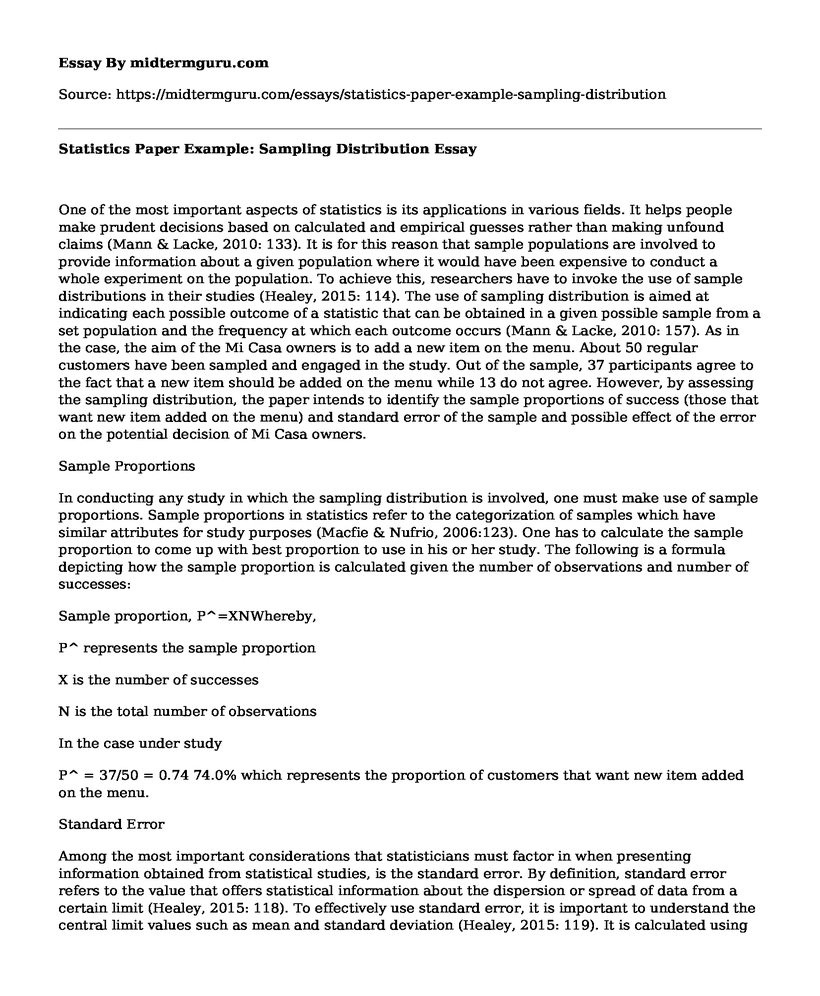One of the most important aspects of statistics is its applications in various fields. It helps people make prudent decisions based on calculated and empirical guesses rather than making unfound claims (Mann & Lacke, 2010: 133). It is for this reason that sample populations are involved to provide information about a given population where it would have been expensive to conduct a whole experiment on the population. To achieve this, researchers have to invoke the use of sample distributions in their studies (Healey, 2015: 114). The use of sampling distribution is aimed at indicating each possible outcome of a statistic that can be obtained in a given possible sample from a set population and the frequency at which each outcome occurs (Mann & Lacke, 2010: 157). As in the case, the aim of the Mi Casa owners is to add a new item on the menu. About 50 regular customers have been sampled and engaged in the study. Out of the sample, 37 participants agree to the fact that a new item should be added on the menu while 13 do not agree. However, by assessing the sampling distribution, the paper intends to identify the sample proportions of success (those that want new item added on the menu) and standard error of the sample and possible effect of the error on the potential decision of Mi Casa owners.
Sample Proportions
In conducting any study in which the sampling distribution is involved, one must make use of sample proportions. Sample proportions in statistics refer to the categorization of samples which have similar attributes for study purposes (Macfie & Nufrio, 2006:123). One has to calculate the sample proportion to come up with best proportion to use in his or her study. The following is a formula depicting how the sample proportion is calculated given the number of observations and number of successes:
Sample proportion, P^=XNWhereby,
P^ represents the sample proportion
X is the number of successes
N is the total number of observations
In the case under study
P^ = 37/50 = 0.74 74.0% which represents the proportion of customers that want new item added on the menu.
Standard Error
Among the most important considerations that statisticians must factor in when presenting information obtained from statistical studies, is the standard error. By definition, standard error refers to the value that offers statistical information about the dispersion or spread of data from a certain limit (Healey, 2015: 118). To effectively use standard error, it is important to understand the central limit values such as mean and standard deviation (Healey, 2015: 119). It is calculated using the following formula:
SEx=SN0.5Whereby;
SEx is the standard error
S is the standard deviation of the mean
N is the sample size
Standard deviation
The following is the measure of spread or standard deviation for the case under study:
S=(p*(1-p)/(n)^0.5 = 0.74*(1 0.74) / (50) ^0.5
= 0.027209
The mean of the information provided in the case is as follows:
= 0.74
Therefore, standard error = 0.027209/0.74 = 0.03677
Conclusion
From the assessment, it can be concluded that the proportion of success for the Mi Casa Restaurant decision is 74% or 0.74. However, the success or failure of the decision is 3.677% represented as 0.74 0.0377, which shows the impact of standard error.
References
Healey, J. (2015). Statistics: a tool for social research. Australia Stamford, CT: Cengage Learning.
Macfie, B. & Nufrio, P. (2006). Applied statistics for public policy. Armonk, N.Y: M.E. Sharpe.
Mann, P. & Lacke, C. (2010). Introductory statistics. Hoboken, NJ: John Wiley & Sons.
Cite this page
Statistics Paper Example: Sampling Distribution. (2021, May 31). Retrieved from https://midtermguru.com/essays/statistics-paper-example-sampling-distribution
If you are the original author of this essay and no longer wish to have it published on the midtermguru.com website, please click below to request its removal:
- Example of a Paper on Statistical Techniques
- Discussion of My Personal Progress in Research Process
- Essay on Fishers Linear Discriminant Analysis
- Significance of Statistics - Paper Example
- Johnson & Johnson Company SWOT and Target Market Analysis - Research Paper
- Epidemiology Research: Cohort, Cross-Sectional, & Randomized Studies - Research Paper
- Workplace Incivility: A Growing Challenge in Our Organization - Essay Sample







